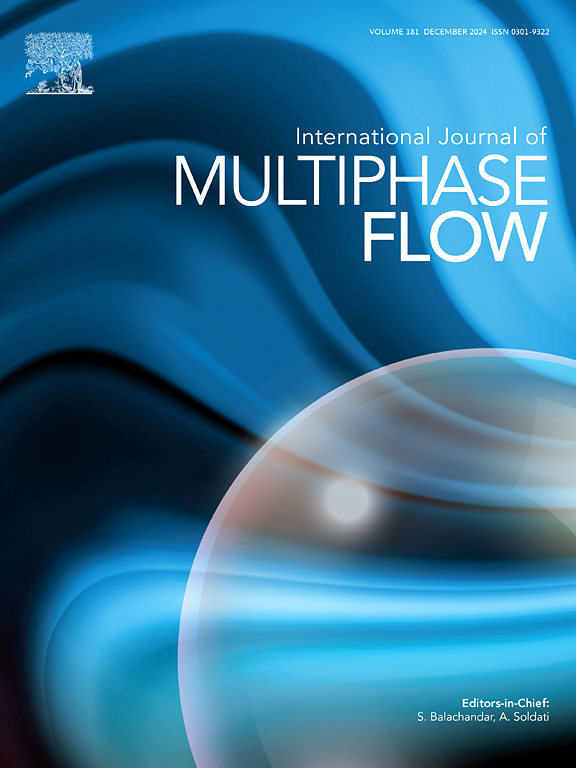解开重力驱动段塞流复杂不稳定机制的动力学
IF 3.6
2区 工程技术
Q1 MECHANICS
International Journal of Multiphase Flow
Pub Date : 2025-04-03
DOI:10.1016/j.ijmultiphaseflow.2025.105230
引用次数: 0
摘要
段塞流稳定性是两相流研究的一个关键前沿,但目前对发展中地区不稳定重力驱动段塞流的复杂动力学研究有限。尽管经过数十年的研究,一些不确定性仍然存在,特别是关于驱动流动不稳定的复杂机制。这些不确定性包括不稳定性的系统分类,它们的相互依赖性或孤立性,它们的持久性或短暂性,以及它们是否表现出混沌或周期性行为。此外,关于它们的时间动态——它们是快速发展还是逐渐发展——它们的相对强度,以及它们在与整体流发展相互作用时的时空传播,这些问题仍然存在。此外,尚不清楚重力是否会诱发新的不稳定模式,这些模式表现出哪些独特的特征,以及气体密度如何调节不稳定动力学。此外,完全稳定的流动状态是否能够实现,或者这是一个难以捉摸的理想状态?最关键的是,如何有效地诊断不稳定性,跟踪其进展,并在操作限制下实时确定稳定的开始?由于缺乏能够同时分析两相流不稳定性固有的多层复杂性的强大框架,解决这些问题一直具有挑战性。为了克服这一限制并解释上述问题,我们引入了一种新的人工智能辅助、数据驱动、尺度无关的时空光谱分析框架,集成了先进的信号处理技术——递归定性分析、快速傅立叶变换、离散和连续小波变换——来分析空气和二氧化碳水重力驱动的段塞流中四个空间位置捕获的空隙率信号。高速成像补充了分析,提供了对瞬态不稳定机制的视觉洞察。分析还绘制了不稳定性图,系统地对不稳定性机制进行分类,同时描绘了它们之间的相互联系。卷积神经网络提取特征,将分析框架转化为快速响应、实时诊断和预测工具,准确率达到96%。这代表了在诊断不稳定性、跟踪其演变和识别段塞流稳定化开始方面的突破。通过将分析精度与实时能力相结合,这种数据驱动、尺度无关的框架为分析和控制不同维度的复杂两相流系统建立了新的基准。本文章由计算机程序翻译,如有差异,请以英文原文为准。

Unlocking the dynamics of complex instability mechanisms in developing gravity-driven slug flows
Slug flow stability stands as a critical frontier in two-phase flow research, with limited focus on the complex dynamics governing unstable gravity-driven slug flows in developing regions. Despite decades of research, several uncertainties persist, particularly regarding the complex mechanisms driving the flow instabilities. These uncertainties encompass the systematic classification of instabilities, their interdependence or isolation, their persistence or transience, and whether they exhibit chaotic or periodic behavior. Additionally, questions remain about their temporal dynamics—whether they evolve rapidly or gradually—their relative intensity, and their spatiotemporal propagation as they interact with overall flow development. Moreover, it remains unclear whether gravity induces new instability modes, what distinct characteristics these modes exhibit, and how gas density modulate instability dynamics. Furthermore, can a fully stabilized flow state ever be attained, or is it an elusive ideal? Most critically, how can one effectively diagnose instabilities, track their progression, and pinpoint stabilization onset in real time under operational constraints? Addressing these questions has been historically challenging due to the lack of a robust framework capable of simultaneously analyzing the inherent multi-layered complexities of two-phase flow instabilities. To overcome this limitation and provide explanations for the above-mentioned questions, we introduce a novel AI-assisted, data-driven, scale-independent spatiotemporal-spectral analysis framework, integrating advanced signal processing techniques—Recurrence Qualification Analysis, Fast Fourier Transform, and Discrete and Continuous Wavelet Transforms—to analyze void fraction signals captured at four spatial locations in air- and CO2-water gravity-driven slug flows. High-speed imaging complements the analysis, offering visual insights into transient instability mechanisms. The analysis also charts an instability map, systematically classifying instability mechanisms while depicting their interconnections. A Convolutional Neural Network extracts features, transforming the analysis framework into a fast-response, real-time diagnostic and predictive tool, achieving an accuracy of 96 %. This represents a breakthrough in diagnosing instabilities, tracking their evolution, and identifying the onset of stabilization within slug flows. By bridging analytical precision with real-time capabilities, this data-driven, scale-independent framework establishes a new benchmark for the analysis and control of complex two-phase flow systems of varying dimensions.
求助全文
通过发布文献求助,成功后即可免费获取论文全文。
去求助
来源期刊
CiteScore
7.30
自引率
10.50%
发文量
244
审稿时长
4 months
期刊介绍:
The International Journal of Multiphase Flow publishes analytical, numerical and experimental articles of lasting interest. The scope of the journal includes all aspects of mass, momentum and energy exchange phenomena among different phases such as occur in disperse flows, gas–liquid and liquid–liquid flows, flows in porous media, boiling, granular flows and others.
The journal publishes full papers, brief communications and conference announcements.

 求助内容:
求助内容: 应助结果提醒方式:
应助结果提醒方式:


